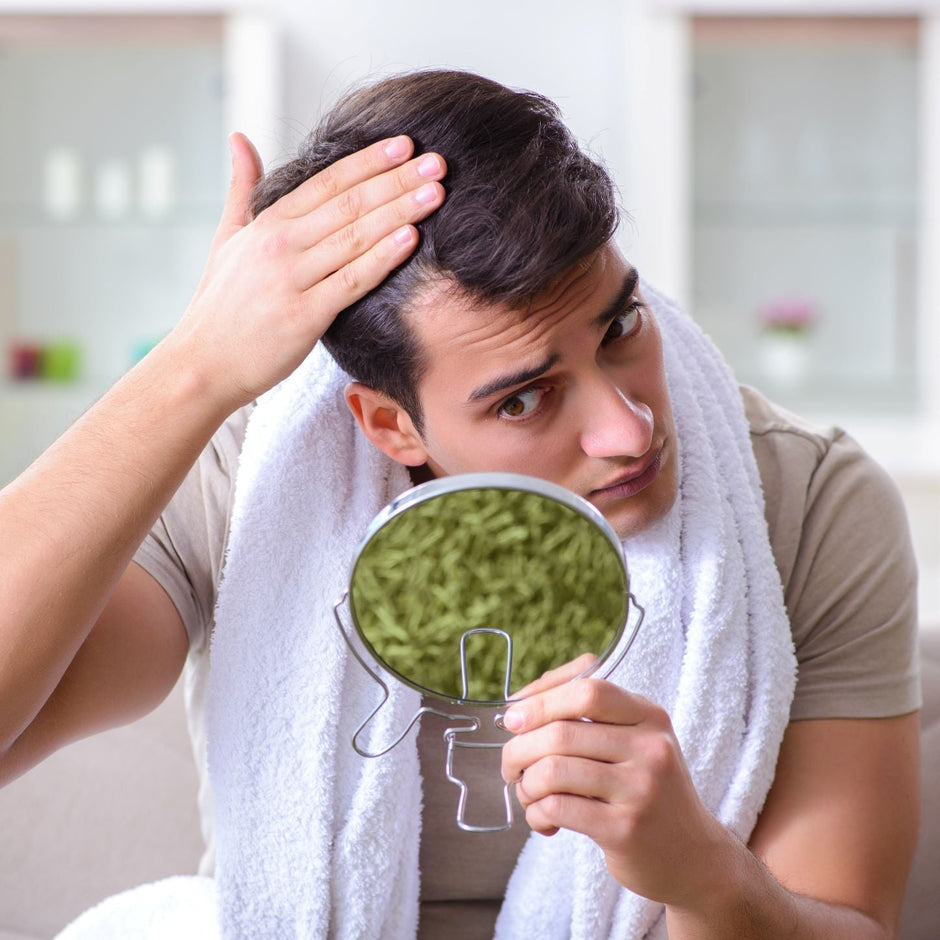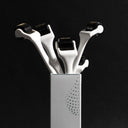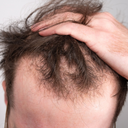Hair loss is one of the most distressing and difficult issues that many men face in their quest for hair management. The problem with hair loss is that it can lead to a receding hairline, which can lead to a host of other problems in terms of self-confidence, self-esteem, and appearance.
If you have a receding hairline, this article will provide you with expert advice on how to manage it. This includes understanding what causes receding hairlines, noticing the early signs of receding hairlines, and different remedies you can use for your receding hairline.
Having a receding hairline can be a cause of concern for going bald, but treatments and solutions have been made available to restore that precious hairline of yours. Find out more in this article!
Source: Ben Arthur
Table of content
What Is a Receding Hairline?
A receding hairline type is when you notice your hairline being stretched backward, giving you a massive forehead. There are times when there is uneven receding of the hairline, usually on the temples of the forehead. It is in the shape of M or which is more commonly known as Widow's Peak.
The reason for uneven receding hairline is because some areas are affected more than others. Those areas can have a high concentration of DHT, which can also lead to chronic scalp tension.
A chronic scalp tension happens when Galea Appunurontica is transmitted. It gives off a signal to the androgenic tissues, which get affected by alopecia. These tissues end up getting inflamed and damage the hair follicle, leading to hair loss.
A receding hairline can be seen as a bad hairline, which makes your forehead appear larger than before that compromises your appearance. Although having a receded hairline is common among men, it is not a natural maturation process. Receding hairline is an underlying cause of a genetic condition called Androgenetic Alopecia (AGA). AGA is also popularly known as Male Pattern Baldness.
Male pattern baldness is a genetic disease for hair loss. Men, if below 35, start experiencing a receding hairline of patches of lost hair, especially in the middle of their heads, which means that they might be going through the Male Pattern Baldness.
Male pattern baldness happens because high levels of Diyhtertostrone (DHT) miniaturizes the hair follicle, starving them of nutrition such as amino acids for hair, and causing hair loss. DHT is primely known to contribute to thin and weak hair on the head and eventually leading to hair shedding.
The receding hairline depicts a horseshoe pattern on men's heads. The unusual M shape is followed by hair falling off from the sides and the middle of the scalp, leading to bald spots.
As your leading source for hair health information over the past 4 years, we never compromise on accuracy. When it comes to your health, you deserve information you can truly rely on - and earning your trust is our top priority.
Here's how Scandinavian Biolabs ensures every piece of content meets the highest standards of accuracy and integrity:
- Credentialed Experts: Our reviewers are actively practicing doctors and medical researchers
- Stringent Reviews: Content undergoes rigorous editing by subject specialists and review by a practicing doctor.
- Evidence-Based: We rely on well-established research from trusted scientific sources like peer-reviewed journals and health authorities.
- Full Transparency: Our editorial standards, writer credentials, reviewer credentials, correction process, and funding are all publicly documented.
- Independent Voice: While we do promote products, we operate in a vacuum to business operations. Our main goal is just an unwavering commitment to providing medically-sound guidance.
You can count on Scandinavian Biolabs to consistently deliver the trustworthy health information you deserve. Read our Editorial Standards.
What Causes a Receding Hairline?

Studies have concluded that an average person has about one hundred thousand hairs that are grown from the hair follicle. All these hairs go through the growth phases, meaning they will fall and regrow.
An average person loses up to 100 strands of hair per day, losing more than that can ensure an underlying cause which can be medical or genetic. Either way, if the growth phases are interrupted or are imbalanced, they can cause a receding hairline.
There are few factors enlisted below that can explain what causes receding hairline:
Age
As men start to age, they start losing their hair as well. This changes the hairline type. According to a study, around 80% of European men had a receding hairline as they aged up to 80 years old. We can say that it is a natural process of going old. Hair loss occurs once you grow old, either you are a male or a female.
Although aging is a factor of hair loss and receding hairline, other factors can cause hair follicles to damage as well, which will eventually lead to baldness and receding hairline.
Family history
If anyone from your family has a receding hairline, there is a big possibility that you will inherit those traits as well. Men with a family history of hair loss are more prone to going bald. Hair loss can be similar in all generations. So you might need to look out for ways to avoid accelerating the process of inherited receding hairline.
Hormone changes
Hormonal changes can cause male pattern hair loss. With a high level of production of DHT, the hair follicles will produce thin and weak hairs that will eventually disappear altogether. It can also lead to the receding hairline as hair loss is directly linked with it. That's why people often seek ways to remove DHT from scalp.
Medications or treatments
Unfortunately, there are some medicines and treatments that can cause hair fall such as gabapentin.
Another standard example is chemotherapy. The excess radiation can cause damage to the hair follicles and cause hair fall. There are also some steroid drugs given to patients for lung diseases that can cause hormonal changes in the body, which again leads to hair loss.

Illness or stress
When people experience a rapid hair fall, that is called Telogen effluvium. The period lasts for 3 to 6 months and affects around 70% of the hair. Telogen effluvium gets triggered by stress and illness in oneself. Having too much stress and anxiety will eventually cause hair loss and a receding hairline.
Lifestyle choices
Some lifestyle choices can cause you more harm than you imagine in the longer run.
For example, people who smoke a lot or drink a lot may face many medical implications along with hair loss.
People who smoke regularly will kick start their hair loss process earlier than those who do not smoke.
Moreover, it is very vital to know what you put in your body. A healthy diet will bring out healthy outcomes for you and your hair, but a poor diet will lead to hair loss. Protein is the biggest factor in enhancing hair growth, and not getting enough protein will cause you to lose hair.
Why Do You Have a Receding Hairline?

No family history of baldness? And you are still developing a receding hairline? Well, this is the time you need to ask yourself if there are some things that you are missing to find the cause of your hair loss.
Explore the cause of your receding hairline with these questions:
- Am I taking any medications that can cause hair loss?
- Do I need to change my lifestyle?
- Do I eat unhealthy food and have a poor diet?
- Am I overworked?
- Do I use too many hair chemical products for styling?
If your answer to any one of the above is Yes, you should know that it can be a reason for your hair loss. Other than hereditary reasons, one can experience a receding hairline if one makes choices that can contribute to hair loss.
Receding Hairline vs. Mature Hairline
A receding hairline can be pretty similar to maturing hairlines, but they have some definite differences.
- Receding hairlines can occur fast and unevenly while maturing hairlines take a long process to mature the hairlines and have are relatively straight and regular.
- There are irregular bald spots and hair loss along the hairlines in receding hairlines; but in maturing hairlines, the hairline does not go past the anterior outline of ears.
- Receding hairlines are caused by hair fall where the regrown hair is thin and weak while hair growth in the maturation phase is healthy and thick.
If a person is not aware of maturing hairlines, then he might not know the differences.
What Are the Symptoms of a Receding Hairline?

Men in their late 30s start to experience a receding hairline, which usually starts with early signs of balding i.e. hair loss from above the temples and goes back to the top of the head, leading the hair closer to the forehead in the middle.
Moreover, there are some bald spots in the middle of the head, showing a bald scalp.
Other than bald spots, the receding hairline is usually seen as a V-shaped pattern or more often called widow’s peak.
The back of the head along with the sides can have very little to no hair, which men usually shave off.
How Do You Diagnose a Receding Hairline?

There are several diagnoses performed by the experts to see if a person is going through hair loss. It can be the leading cause of a receding hairline.
- Medical History: Personal Medical History is used to check if the person has any other illness or if any medication should be short-listed for the loss of hair.
- Family Medical History: This is to ensure if the problem is hereditary and runs in the family.
- Pull Test: the doctor might gently pull few strands to check the strength of the hair; if more than six strands come out, this means that the person is experiencing male pattern hair loss.
- Biopsy: Biopsy will help determine if there is any scalp infection. It will take a part of your scalp tissue for a sample and get it checked for any disease or infection. If the results come positive, it might be causing hair loss.
It is recommended to consult your doctor for a thorough check-up and evaluating what is causing a receding hairline.
How Is Receding Hairline Prevented?
Many ways can help you treat your hair loss problems which will automatically fix your receding hairline. If the hair loss is due to the age factor, and no other medical issue then you might not need treatment, but if it is then there are some recommended medications.
Minoxidil
Minoxidil is an over-the-counter product that can help restore lost hair. Minoxidil's famous brand is called Rogaine. This product has worked better than the placebo in many research. Want to know more about does Minoxidil work for a receding hairline? Read about it in our article.
It comes in a liquid form that is used to rub over the head. It gives a better circulation flow to the scalp, which can be effective in restoring hair growth. Side effects associated with using Minoxidil are rashes, scalp irritation, and redness.
Finasteride

Popularly known as Propecia, is a pill to restore hair growth. It is only available as per the doctor's prescription. This medicine decreases the hormone levels, DHT, which causes hair fall. It is widely consumed to grow hair and stop hair loss.
Sometimes people use Minoxidil alongside Finasteride to get better results. Although Finasteride's side effects are rare, they can cause sexual dysfunctions and increase the risk of prostate cancer.
DHT blocker shampoos
There are some shampoos specifically designed to stimulate hair growth and stop hair fall. The ingredients used in the shampoos are green tea formula, DHT blockers, caffeine, natural oils, and ketoconazole.
Biotin
Biotin solutions are the solution to increasing the growth of hair. They are not known to stop hair loss completely but are effective for hair growth. They are safe to use and apply on any treated or dyed hair.
In fact, here at Scandinavian Biolabs, we have our trademarked Bio-Pixilin formula that is so powerful and effective that we guarantee you its result. If our products don't show you results, you get 100% money-back.

Hair transplant surgery
Many have resorted to hair restoration surgery. The procedure involves taking a section of the scalp where the hair follicles are still working and transplanting it on the bald spots of the head or where the hair has completely stopped regrowing. The skin will be able to regrow hair which is healthy and thick.
The implanted sections will help you fix your receding hairline.
The con of having a hair transplant surgery is that it is expensive. If you do not have health insurance, it will be hard to cover the risks of this treatment.
Herbs, aloe vera and essential oils
Alongside many medications and chemical solutions, natural solutions are also available.
People with receding hairlines can apply herbal solutions which can help stimulate healthy hair growth:
- Chinese hibiscus
- Ginseng
- Gooseberry
- Essential oils
- Aloe vera
All of these natural solutions can be turned into oils and applied to the head for better conditioning. These are the vital traditional medication for the treatment of hair loss.
What Contributes to a Receding Hairline?
We know that many factors can cause a receding hairline such as age and genetics. But few other factors contribute to a receding hairline and eventually leading to hair loss.
These factors are:
- Using chemicals to style can damage your hair.
- Going for tight hairstyles that can stretch your hair back. If these hairstyles get styled up for a longer time, it can cause a receding hairline.
- Curling and straightening your hair too much can damage your hair with all that heat.
- Having a poor diet; not taking enough proteins.
- Stressing out too much can lead to further hair loss.
- Smoking regularly will quicken the hair loss phase in people than the ones who don’t smoke.

When to See a Doctor?
It is vital to know that hair fall up to 100 strands a day is normal. People with thicker hair sometimes lose up to 200 strands of hair. It is normal. What is abnormal is rapid hair loss and more than what's been called average.
Directly consult a doctor once you start experiencing these symptoms:
- Rapid hair loss
- Bald spots
- Thinning hair
- When you lose patches from the scalp
- Weaker hair
There is a possibility for another health reason that can cause hair loss for example thyroid, which will start from a receding hairline. If you are worried about any health issues or your hair in general, consult an expert.
Mental Health and Receding Hairline

As we already know that having bad mental health can affect your body in many ways, one of them is your hair. To avoid losing all your hair due to poor mental health, you must seek ways to keep yourself healthy, physically and mentally.
That said, mental health can have a significant impact on our bodies and minds, otherwise it can lead to stress and depression. Depression is known to be a cause for losing hair that leads to thinning of hair and a receding hair line. It is recommended to take time for yourself to nurture your mind.
There are many ways one can try to keep your mental health in check:
- Eating healthy
- Sleeping well
- Consulting a therapist
- Relaxation techniques
- Exercising
- Going out with friends and family
- Confiding your problems with someone close
Studies have found that people who are mentally strong are able to produce healthier and thicker hair.
Conclusion

If you notice or feel anything unusual about your appearance or hairline, quickly act at your earliest. If the cause is male pattern baldness or female pattern hair loss, it can lead to rapid hair loss, and from having a receding hairline, you might have no hairline left.
With all the hair loss treatments, the most important thing is patience. It is vital to let these solutions have their time before they start working. These changes require a lot of time and patience. In the end, we recommend always take up to your doctor if any concerning symptoms pop up.
Read more:
References
- Yoon SH, Burm JS, Yang WY, Kang SY. Vascularized bipedicled pericranial flaps for reconstruction of chronic scalp ulcer occurring after cranioplasty. Arch Plast Surg. 2013 Jul;40:341–7.
- Beigi PKM. Androgenetic Alopecia (AGA) [Internet]. Alopecia Areata. 2018. p. 33–7. Available from: http://dx.doi.org/10.1007/978-3-319-72134-7_7
- Male pattern baldness [Internet]. SpringerReference. Available from: http://dx.doi.org/10.1007/springerreference_41758
- Phillips ML. Clues to the cause of male pattern baldness [Internet]. Nature. 2012. Available from: http://dx.doi.org/10.1038/nature.2012.10277
- Differential Expression between Human Dermal Papilla Cells from Balding and Non-Balding Scalps Reveals New Candidate Genes for Androgenetic Alopecia. J Invest Dermatol. 2016 Aug 1;136:1559–67.
- Brazier Y. Chemotherapy: What it is, what to expect, side effects, and outlook [Internet]. 2019 [cited 2021 Sep 19]. Available from: https://www.medicalnewstoday.com/articles/158401
- Lencastre A, Tosti A. A Receding Hairline [Internet]. Vol. 369, New England Journal of Medicine. 2013. p. e2. Available from: http://dx.doi.org/10.1056/nejmicm1206227
- Falcon CS, Espinoza N, Guzman D. Pull Test and Trichogram [Internet]. Techniques in the Evaluation and Management of Hair Diseases. 2021. p. 30–43. Available from: http://dx.doi.org/10.1201/9780367855147-4
- Al-Refu K. Scalp Biopsy and Diagnosis of Common Hair Loss Problems [Internet]. Skin Biopsy - Diagnosis and Treatment. 2013. Available from: http://dx.doi.org/10.5772/55025
- Miteva M, Tosti A. Dermoscopy guided scalp biopsy in cicatricial alopecia [Internet]. Journal of the European Academy of Dermatology and Venereology. 2012. p. no – no. Available from: http://dx.doi.org/10.1111/j.1468-3083.2012.04530.x
- Thiboutot D. Propecia Dosages [Internet]. Vol. 135, Archives of Dermatology. 1999. p. 1417–1417. Available from: http://dx.doi.org/10.1001/archderm.135.11.1417
- Iyengar H, Brenham C. Is combination therapy with an alphablocker and a DHT blocker better than either agent alone for long-term management of benign prostatic hypertrophy (BPH)? [Internet]. Vol. 19, Evidence-Based Practice. 2016. p. E10–1. Available from: http://dx.doi.org/10.1097/01.ebp.0000541593.25491.ee
- Yates WD, McIntyre R. An overview of Biotin as it relates to hair loss [Internet]. Vol. 23, International Society of Hair Restoration Surgery. 2013. p. 52–3. Available from: http://dx.doi.org/10.33589/23.2.0052
- Trüeb RM. Comment on the Use of Biotin for Hair Loss [Internet]. Vol. 4, Skin Appendage Disorders. 2018. p. 345–6. Available from: http://dx.doi.org/10.1159/000484489
- Vallis CP. Surgical Treatment of the Receding Hairline [Internet]. Vol. 40, Plastic and Reconstructive Surgery. 1967. p. 138–46. Available from: http://dx.doi.org/10.1097/00006534-196708000-00004
- Mishra S. Hair Transplant Complications [Internet]. Hair Transplant Surgery. 2014. p. 119–119. Available from: http://dx.doi.org/10.5005/jp/books/12358_12
- Tabakova V. How to Grow Long Hair with Herbs, Vitamins and Gentle Care: Natural Hair Care Recipes for Hair Growth and Health. 2017. 46 p.
- Bergfeld WF, Alan Andersen F. Natural Products for Hair Care and Treatment [Internet]. Hair Growth and Disorders. p. 515–24. Available from: http://dx.doi.org/10.1007/978-3-540-46911-7_26
- Sadrolodabaei FS, Pathomvanich D, Palakurthi R. Letters to the Editors: Re: Is There a Relationship Between Receding Hairline and Hairstyle? [Internet]. Vol. 20, International Society of Hair Restoration Surgery. 2010. p. 104–104. Available from: http://dx.doi.org/10.33589/20.3.0104





